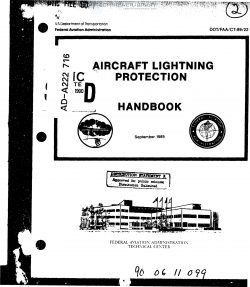DOT-FAA-CT-89-22
- Version
- 1801 Downloads
- 35.82 MB File Size
- 1 File Count
- March 5, 2017 Create Date
- March 5, 2017 Last Updated
Aircraft Lightning Protection Handbook

This handbook will assist aircraft design and cer- tification engineers in protecting aircraft against the direct and indirect effects of lightning strikes, in com. pliance with Federal Aviation Regulations pertaining to lightning protection. It is also intended 10 assist FAA certifying engineers in assessing the adequacy of proposed lightning protection designs. It will also be useful for designers of major subsystems, such en- gines and electrical and avionics systems, This is the second handbook of this type. The first such handbook, also entitled Lightning Protec- tion Of Aircraft by F.A. Fisher and J.A. Pltuner, was published in 1976 by the National Aeronautics and Space Administration as N4SA RP—1008. Since that book was published there have been major advances in protection techniques, standards and test practices, particularly in those dealing with the indirect electro- magnetic effects of lightning. This new handbook, which was commissioned by the FAA in 1986, was originally intended to be an up- dated version of NASA RP—1008, but as the project evolved, it became evident that additional topics, not included in the earlier book, should be incorporated and that much of the original material needed to be completely rewritten and expanded. The book is organized along the same general lines as the earlier work, with the first half dealing with the direct effects (burning and blasting) of lightning and the second half dealing with the indirect effects (electromagnetic induction of voltages and currents) of lightning.
Among the new material found in this book are two chapters dealing with basic technologies and phys- iCal concepts. The first of these, Chapter 1 - An Intro- duction to High Voltage Phenomena, deals with the nature of high voltage electrical sparks and arcs and with related processes of electric charge formation, ion- ization, and spark propagation in air. All of these are factors that affect the way that lightning leaders attach to an aircraft and the way that the hot return stroke arc affects the surface to which it attaches. The ma- terial introduce practices and terms for years in the electric power industry, but which are not commonly studied by those dealing with aircraft. Thoæ terms and practices have, however, affected the tests and practices used to evaluate the direct effects of lightning on aircraft.
| File | Action |
|---|---|
| DOT-FAA-CT-89-22 Aircraft Lightning Protection Handbook.pdf | Download |

Comment On This Post